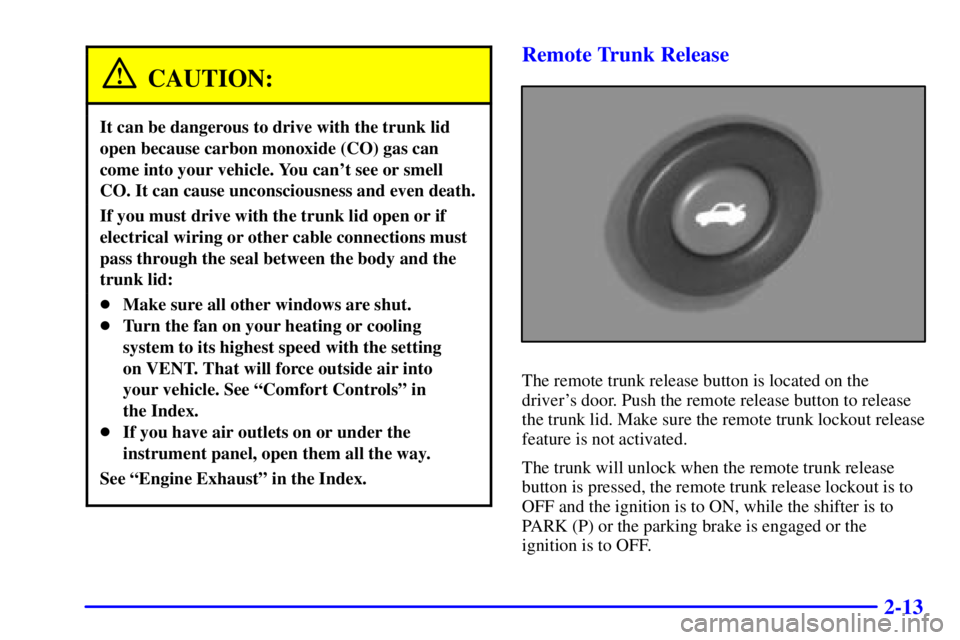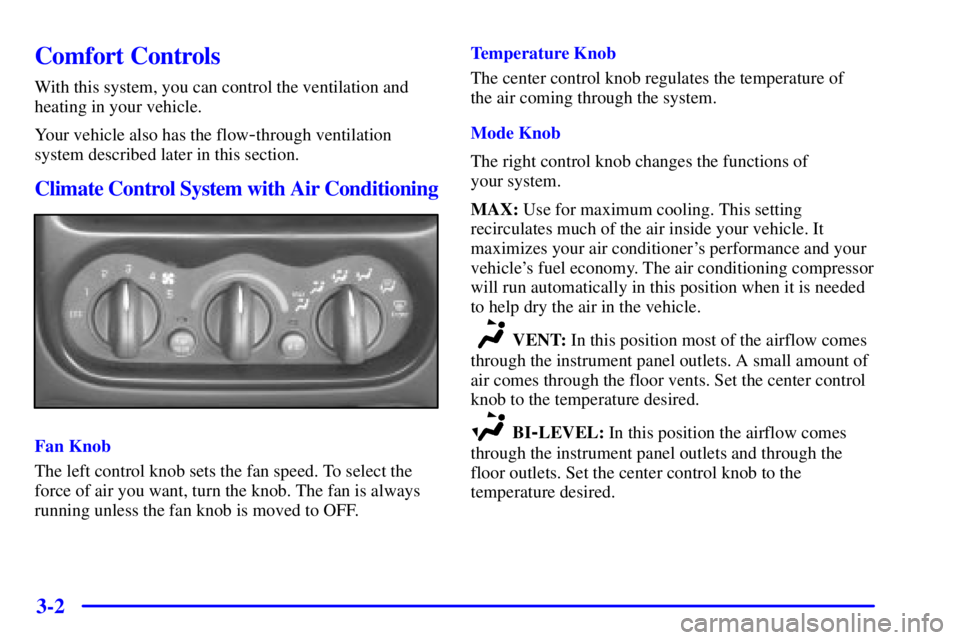Page 5 of 318
iii
Section
3
Comfort Controls and Audio Systems
Section
4
Your Driving and the Road
Section
5
Table of Contents (cont'd)
Defensive Driving
Drunken Driving
Control of a Vehicle
Braking
Enhanced Traction SystemSteering
Driving Tips for Various Road Conditions
Recreational Vehicle Towing
Loading Your Vehicle
Towing a Trailer Heating and Air Conditioning
Setting the Radio Clock
Radio/Cassette Player/CD PlayerRadio Theft-Deterrent Feature
Steering Wheel Controls (If Equipped)
Hazard Warning Flashers
Jump Starting
Towing Your VehicleEngine Overheating
Changing a Flat Tire
If You're Stuck
Problems on the Road
Page 78 of 318

2-13
CAUTION:
It can be dangerous to drive with the trunk lid
open because carbon monoxide (CO) gas can
come into your vehicle. You can't see or smell
CO. It can cause unconsciousness and even death.
If you must drive with the trunk lid open or if
electrical wiring or other cable connections must
pass through the seal between the body and the
trunk lid:
�Make sure all other windows are shut.
�Turn the fan on your heating or cooling
system to its highest speed with the setting
on VENT. That will force outside air into
your vehicle. See ªComfort Controlsº in
the Index.
�If you have air outlets on or under the
instrument panel, open them all the way.
See ªEngine Exhaustº in the Index.
Remote Trunk Release
The remote trunk release button is located on the
driver's door. Push the remote release button to release
the trunk lid. Make sure the remote trunk lockout release
feature is not activated.
The trunk will unlock when the remote trunk release
button is pressed, the remote trunk release lockout is to
OFF and the ignition is to ON, while the shifter is to
PARK (P) or the parking brake is engaged or the
ignition is to OFF.
Page 113 of 318

2-48
Storage Compartments
Glove Box
Use the key to lock and unlock the glove box.
To open, pull the glove box handle up.
Center Console Storage Area
The center console has two separate storage areas. The
upper compartment, which is also the armrest, can be
used to store maps, gloves, etc. To open, pull up on the
driver's side of the lid.
Rear Seat Cupholder
Pull down the door on the rear of the center console to
use the rear seat cupholder.
Convenience Net (If Equipped)
Your vehicle may have a convenience net. You'll see it
just inside the back wall of the trunk.
Put small loads, like grocery bags, behind the net. It can
help keep them from falling over during sharp turns or
quick starts and stops.
The net isn't for larger, heavier loads. Store them in the
trunk as far forward as you can.
You can unhook the net so that it will lie flat when
you're not using it.
Ashtray and Lighter (If Equipped)
To use the lighter, just push it in all the way and let go.
NOTICE:
Don't put papers and other things that burn into
your ashtrays. If you do, cigarettes or other
smoking materials could set them on fire,
causing damage.
NOTICE:
Don't hold a cigarette lighter in with your hand
while it is heating. If you do, it won't be able to
back away from the heating element when it's
ready. That can make it overheat, damaging the
lighter and the heating element.
You can also remove the cigarette lighter to plug in
additional accessories. Be sure to follow the proper
installation instructions that are included with any
electrical accessory you install.
Page 124 of 318

2-59 Enhanced Traction System Active Light
When your Enhanced
Traction System is
limiting wheel spin,
this light will come on.
Slippery road conditions
may exist if the Enhanced
Traction System active light
comes on, so adjust your
driving accordingly.
The light will stay on for a few seconds after the
Enhanced Traction System stops limiting wheel spin.
This light will also come on when the anti
-lock brake
system is active.
The Enhanced Traction System active light also comes
on briefly when you turn the ignition key to ON. If the
light doesn't come on then, have it fixed so it will be
there to tell you when the system is active.
Engine Coolant Temperature Gage
United States Canada
This gage shows the engine coolant temperature. If the
gage pointer moves into the red area, the light comes on
and you hear a chime, your engine is too hot! It means
that your engine coolant has overheated.
The ªProblems on the Roadº section of this manual
shows what to do. See ªEngine Overheatingº in
the Index.
Page 125 of 318

2-60 Low Coolant Warning Light
This light comes on
briefly when you turn your
ignition on.
If this light comes on and stays on and you hear a chime,
the vehicle should promptly be pulled off the road and
the coolant level checked.
See ªEngine Coolantº in the Index. If there are visible
signs of steam, see ªEngine Overheatingº in the Index
before opening the hood. Have your vehicle serviced as
soon as you can.
Malfunction Indicator Lamp
(Service Engine Soon Light)
Your vehicle is equipped
with a computer which
monitors operation of the
fuel, ignition and emission
control systems.
This system is called OBD II (On
-Board
Diagnostics
-Second Generation) and is intended to
assure that emissions are at acceptable levels for
the life of the vehicle, helping to produce a cleaner
environment. The SERVICE ENGINE SOON light
comes on to indicate that there is a problem and service
is required. Malfunctions often will be indicated by the
system before any problem is apparent. This may
prevent more serious damage to your vehicle. This
system is also designed to assist your service technician
in correctly diagnosing any malfunction.
Page 133 of 318
3-
3-1
Section 3 Comfort Controls and Audio Systems
In this section, you'll find out how to operate the comfort control and audio systems offered with your vehicle.
Be sure to read about the particular systems supplied with your vehicle.
3
-2 Comfort Controls
3
-2 Climate Control System with Air Conditioning
3
-3 Air Conditioning
3
-4 Heating
3
-4 Defogging and Defrosting Windows
3
-5 Rear Window Defogger
3
-5 Ventilation System
3
-6 Audio Systems
3
-6 Setting the Clock for All Systems Except
AM
-FM Stereo
3
-7AM-FM Stereo with Cassette Tape Player3
-10 AM-FM Stereo with Compact Disc Player
and Equalizer (If Equipped)
3
-13 Remote Cassette Tape Player (If Equipped)
3
-14 Theft-Deterrent Feature (If Equipped)
3
-17 Audio Steering Wheel Controls (If Equipped)
3
-18 Understanding Radio Reception
3
-18 Tips About Your Audio System
3
-19 Care of Your Cassette Tape Player
3
-20 Care of Your Compact Discs
3
-20 Care of Your Compact Disc Player
3
-20 Fixed Mast Antenna
Page 134 of 318

3-2
Comfort Controls
With this system, you can control the ventilation and
heating in your vehicle.
Your vehicle also has the flow
-through ventilation
system described later in this section.
Climate Control System with Air Conditioning
Fan Knob
The left control knob sets the fan speed. To select the
force of air you want, turn the knob. The fan is always
running unless the fan knob is moved to OFF.Temperature Knob
The center control knob regulates the temperature of
the air coming through the system.
Mode Knob
The right control knob changes the functions of
your system.
MAX: Use for maximum cooling. This setting
recirculates much of the air inside your vehicle. It
maximizes your air conditioner's performance and your
vehicle's fuel economy. The air conditioning compressor
will run automatically in this position when it is needed
to help dry the air in the vehicle.
VENT: In this position most of the airflow comes
through the instrument panel outlets. A small amount of
air comes through the floor vents. Set the center control
knob to the temperature desired.
BI-LEVEL: In this position the airflow comes
through the instrument panel outlets and through the
floor outlets. Set the center control knob to the
temperature desired.
Page 136 of 318

3-4 Heating
On cold days, use FLOOR with the temperature knob
all the way in the red area. The system will bring in
outside air, heat it and send it to the floor outlets.
Your vehicle has heat ducts that are directed toward the
rear seat. Keep the area under the front seats clear of
obstructions so that the heated air can reach the rear
seat passengers.
If your vehicle has an engine coolant heater, you can
use it to help your system provide warm air faster when
it's cold outside (0�F (
-18�C) or lower). An engine
coolant heater warms the coolant your engine and
heating system use to provide heat. See ªEngine
Coolant Heaterº in the Index.
Defogging and Defrosting Windows
Your system has two settings for clearing the front and
side windows. For each setting, adjust the temperature
control as desired.
To defrost the front window quickly, turn the temperature
control knob all the way in the red area. Use FRONT
DEFROST and adjust the fan to the highest speed.
To warm passengers while keeping the front window
clean, use DEFOG.
Your vehicle is equipped with side window defogger
vents. The side window defogger vents are located on the
outside of the side instrument panel vents. To defrost the
side windows, turn the temperature control knob all the
way in the red area. Use FLOOR and adjust the fan to
the highest speed. To control fogging of the windows,
turn the temperature control knob all the way in the red
area. Use DEFOG and adjust the fan to the highest speed.
To defog the side windows while using air conditioning,
use BI
-LEVEL and adjust the fan to the highest speed
and press the A/C button so that the indicator light is
glowing. For added airflow to the side windows aim the
side vents toward the windows and close the center vents.